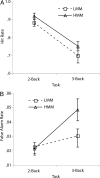Cognitive control in media multitaskers
- PMID: 19706386
- PMCID: PMC2747164
- DOI: 10.1073/pnas.0903620106
Cognitive control in media multitaskers
Abstract
Chronic media multitasking is quickly becoming ubiquitous, although processing multiple incoming streams of information is considered a challenge for human cognition. A series of experiments addressed whether there are systematic differences in information processing styles between chronically heavy and light media multitaskers. A trait media multitasking index was developed to identify groups of heavy and light media multitaskers. These two groups were then compared along established cognitive control dimensions. Results showed that heavy media multitaskers are more susceptible to interference from irrelevant environmental stimuli and from irrelevant representations in memory. This led to the surprising result that heavy media multitaskers performed worse on a test of task-switching ability, likely due to reduced ability to filter out interference from the irrelevant task set. These results demonstrate that media multitasking, a rapidly growing societal trend, is associated with a distinct approach to fundamental information processing.
Conflict of interest statement
The authors declare no conflict of interest.
Figures



Comment in
-
Breadth-biased versus focused cognitive control in media multitasking behaviors.Proc Natl Acad Sci U S A. 2009 Sep 15;106(37):15521-2. doi: 10.1073/pnas.0908642106. Epub 2009 Sep 9. Proc Natl Acad Sci U S A. 2009. PMID: 19805207 Free PMC article. No abstract available.
References
-
- Roberts D-F, Foehr U-G, Rideout V. Generation M: Media in the lives of 8-18 year-olds. Menlo Park, CA: HJKF Foundation; 2005.
-
- Armstrong G-B, Chung L. Background television and reading memory in context: Assessing TV interference and facilitative context effects on encoding versus retrieval processes. Communic Res. 2000;27:327–352.
-
- Furnham A, Bradley A. Music while you work: The differential distraction of background music on the cognitive test performance of introverts and extraverts. Appl Cogn Psychol. 1997;11:445–455.
-
- Cherry E-C. Some experiments on the recognition of speech, with one and with two ears. J Acoust Soc Am. 1953;25:975–979.
Publication types
MeSH terms
LinkOut - more resources
Full Text Sources
Other Literature Sources
Medical

